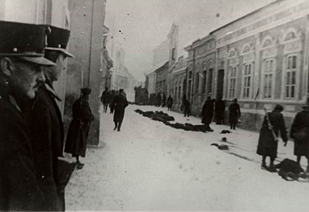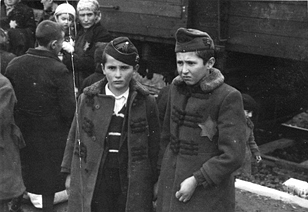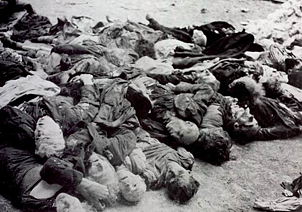The Holocaust in Hungary
Two-thirds of Hungarian Jewry was destroyed between 1941 and 1945. More than half a million people fell victim to the labour service, the deportations organised by German Nazis and their Hungarian henchmen, the brutality of the Hungarian authorities, the death marches, the gassings in Auschwitz, the mass executions, and the terrible circumstances of the concentration camps. Hungarian Jews were murdered on the Ukrainian snow-fields, on the streets of Budapest, in the countryside ghettos, behind the barbed wires of German concentration camps, in the gas chambers of Birkenau, and on the country roads. Every tenth victim of the Holocaust and every third victim of Auschwitz-Birkenau, the largest Nazi extermination camp, were Hungarian.
Between 1941 and 1944 Hungarian Jewry suffered losses in the tens of thousands. Barely one month after special SS units (Einsatzgruppen) began the systematic murder of Jews in
 |
The massacre at Újvidék |
Still, despite the loss of tens of thousands and the hardship caused by anti-Jewish legislation, until March 1944 the majority of Hungary's Jewish community lived in relative security. In the meantime, in much of occupied Europe, the Holocaust was already in full swing: SS mobile extermination units swept through the eastern territories, death- and forced labour camps were operating and the Jewish communities of Europe were destroyed one after the other. Between 1942 and 1944 the conservative Kállay government, although passing a number of new anti-Jewish laws and making extremist anti-Semitic statements, still rejected German demands aimed at the deportation of Hungarian Jews.
This relative sense of security evaporated on March 19, 1944 when German troops occupied Hungary. The occupation was motivated primarily by the fact that Berlin got wind of cease-fire talks between Hungary and the Allies and Hitler wanted to prevent Hungary from following the example of Italy and deserting the war effort. Moreover, Germany planned to exploit the Hungarian economy more effectively than ever before to cover the increasing costs of the war. The Jewish question played but a secondary role in the country's occupation.
The German army was accompanied by a special unit (Sondereinsatzkommando - SEK) with orders to "dejewify" the country. The SEK was
 |
Hungarian Jewish children in Birkenau, May, 1944 |
Under German pressure, a few days following the occupation, Regent Miklós Horthy appointed a collaborating government ready to serve Nazi interests, led by former ambassador to Berlin Döme Sztójay. Interior ministry officials of the Sztójay cabinet (Minister of the Interior Andor Jaross and State Secretaries László Baky and László Endre) cooperated with the Germans with unexpected zeal. The "final solution of the Jewish question in Hungary" got under way with a speed and efficiency surprising even the Germans: between mid April and late May practically the entire Jewish population of the countryside was ghettoized and, in the largest deportation operation in the history of the Holocaust, between May 15 and July 9, over 437,000 people (with the exception of 10,000-15,000) had been transported to Auschwitz-Birkenau. The speed with which the Hungarian authorities cast out Jews from society, then robbed, segregated and deported them was unprecedented in the entire history of the Holocaust.
By early July 1944 only Budapest Jews and those serving in the labour service units remained in Hungary. The gradually deteriorating
 |
Dead bodies in the large ghetto of Budapest |

